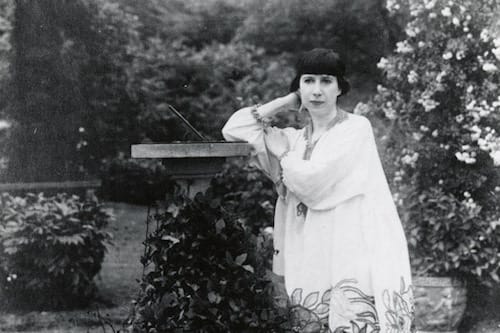Lucy Ives's Case for Florine Stettheimer

Lucy Ives has reviewed the Jewish Museum's Florine Stettheimer: Painting Poetry, a survey of the Rochester-born poet, artist, set- and costume-designer's paintings and drawings that attempted to cast Stettheimer into the serious leagues, but was instead, according to Ives, a "lackluster if jauntily packaged retrospective." "If we want to grapple more seriously with Florine Stettheimer, it is worth returning to Kafka and Céline’s unreal depictions of the US," she writes. More, from Art in America:
...We could well think of Stettheimer on similar terms: as an artist who treated America as an exotic, largely unknowable locale and who used the space of fantasy and escapism this orientation opened up as a source of inspiration, improvising at will. This way of looking at Stettheimer may not endear her to contemporary American audiences, who seem to enjoy her work mainly for its flowers, stars, large-eyed maidens, and ubiquitous crystalline frills. However, highlighting Stettheimer’s interest in allegory and appropriation helps to explain such apparently contradictory impulses as her life-long fascination with the figure of the faun as portrayed by Vaslav Nijinsky in his famous choreography for L’Après-midi d’un faune, a ballet based on a Stéphane Mallarmé poem with a score by Claude Debussy, and her equally powerful obsession with the far less sensuous George Washington, to whom she dedicated an entire shrinelike room in her Bryant Park studio and who repeatedly appears in her paintings.11 From the intently researched exoticism of contemporary designers Léon Bakst, who created sets and costumes for the Ballets Russes, and Paul Poiret, the celebrity couturier who in 1911 held a “Thousand and Second Night” fancy-dress soirée, Stettheimer learned the power of orientalist pastiche.
Critics often note the impact Nijinsky’s June 8, 1912, Paris performance of L’Après-midi d’un faune made on Stettheimer. She immediately began sketching costumes and scenery for her own ballet, the story of a well-heeled father-daughter duo who are accosted by art students and compelled to don Bakstian/Poiretian garb and begin dancing. Though the ballet, L’Orphée des Quat-z-arts, whose title cites an annual Parisian ball, was never staged, Stettheimer’s mock-ups evidence rapt work, including collaged fabric and beading. This early undertaking is usually seen as a sign of the talent that would be more concretely manifested in Stettheimer’s designs for Four Saints in Three Acts. L’Orphée might also be read as an indication of Stettheimer’s fashionable equation of personal liberation with the assumption of non-European dress; the clothing of the art students points to a generalized East, in which the constraints of Western society are imagined not to apply. Indeed, in one of the very few extant photographs of Stettheimer, taken ca. 1917–20 in her Bryant Park garden, she wears a matching set of billowing pantaloons and embroidered white tunic. Stettheimer’s garments are even more loosely cut than Poiret’s iconic “lampshade” tunic ensemble, but the association is unmistakable and incorporates another trend in which Poiret also participated: deliverance from the corset.
Stettheimer thus favored an eccentric exoticism—one in which fauns, George Washingtons, and other stock figures were caricatured and fetishized—over related contemporaneous avant-garde movements, even as she maintained a rather straightforward relationship to the sensuality of paint. The academically trained and always elaborately decorative Stettheimer was, for example, never fully taken with Dada’s sardonic anti-art. The Stettheimer sisters’ liking for puckish Duchamp, aka “Duche,” their sometime French teacher, occasionally took a turn for the patronizing, as when Ettie Stettheimer referred to him as a “charming garçon” or the “queer but charming French boy who painted ‘Nude Descending the Stairs’ and other cubistic creations.”12 Meanwhile, the uncanny imagery and narrative ruptures of Surrealism never caught on with Florine, nor did the movement engage the materiality of paint as much as she might have liked, though comparisons to Leonora Carrington and Remedios Varo are hardly out of place. For Stettheimer did not just daub, she built her faux-naive pictures with an artfully wielded palette knife (which is why it is remarkable that her substantial canvases sometimes look like finely delineated New Yorker covers in reproduction). Stettheimer has also been said to have roots in the European Symbolist tradition, and there are clear parallels between her work and the oneiric images of Odilon Redon, for example. However, to the synthesis of the symbol she clearly preferred the ambivalence and deferral associated with allegory, the effect produced when a thing in a picture does not represent that thing, purely or exclusively, but rather points to something else.13 This current runs so strongly through her work that the very fact that it has not been clearly elaborated by Stettheimer’s critics suggests that the artist’s failure to fully “appear” within either the canon or major American museums may be due as much to this omission as to the artist’s gender. For it is difficult to understand or, for that matter, see Florine Stettheimer, without examining her allegorical depictions of America.
Read all of "The Repatriation of F$."


